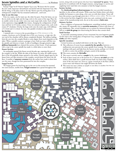 Seven
Spindles and a McGuffin (pdf link) is my entry into the One
Page Dungeon Contest 2012. Much like last year’s entry (which was one of the
winners) this one is more about dungeon structure than compelling
narrative. In fact, the “story” is so minimal in this one that the whole
entry is really more of a sandbox than an adventure. I sort of like
dungeons that way, personally, but mileage varies.
Seven
Spindles and a McGuffin (pdf link) is my entry into the One
Page Dungeon Contest 2012. Much like last year’s entry (which was one of the
winners) this one is more about dungeon structure than compelling
narrative. In fact, the “story” is so minimal in this one that the whole
entry is really more of a sandbox than an adventure. I sort of like
dungeons that way, personally, but mileage varies.
I had some some goals for the design of this dungeon (and some observations after building it):
- Must use a vector-based map. (Why? Well, note that this map is infinitely scalable, but the whole PDF is under 300KB.)
- Wanted a dungeon with a couple totally different vectors of entry.
- Provide the flow control usually supplied by different levels of a dungeon, all using a single map. The center spindle effectively allows this to be a six level dungeon on half a page.
- Take a regional approach, where the dungeon is described by section rather that detailing each room.
- Put some rooms at angles to the grid, but showing the grid in their own frame of reference.
- Subvert the idea of dungeon as node graph idea from last year’s entry. It may be possible to node graph this dungeon, but I’m not entirely sure how to do it, especially since the small spindles are placed at random each time the dungeon is run.
- Minimize hallways (if you were digging your own underground complex, you don’t get much return out of the labor). Some sections do this better than others.
- Because each of the spindles serves eight potential openings, it turns out to be critical that the spindles turn in 45° increments. If they turned in 90° increments, I’m pretty sure that you can get situations where randomly placing the spindles results in unreachable rooms. Turning at 45° increments avoids this, though you might get cases where some rooms can only be reached if you stay in the spindle when it rotates.
- Use psychology against the delvers. For example, in a couple of places, there are short hallways with a normal door on one end and a secret door on the other. The normal door is in the “more secret” area, so the idea is that if the delvers are already in the secret area and go through the normal door, when they find the (obvious) secret door at the other end, their tendency will be to go through it (“it’s secret, it must be protecting something good”), which actually leads them out of the secret area. Not sure if it would shake out like that in play, but that’s the idea.
- Loved the idea of the spindles periodically sealing and unsealing sections, so that air, water and such rush in or out when the spindle moves. Like, if you are in a room with water up to your ankles and, meanwhile, the tide has risen outside, then the spindle turns and the high tide rushes into the room you’re in. Probably should have done more with that notion, but it is a) tough to do in one page and b) hard to explain and use.
- The overlapping technique used in the fissure section, where one room is on top of another with a ladder between them, could have been used more. I thought it might confuse people, even though it is a bit easier to illustrate with the rooms at angles to each other.
I think last year’s entry was stronger, but when I went to the well this time, this is what came out.